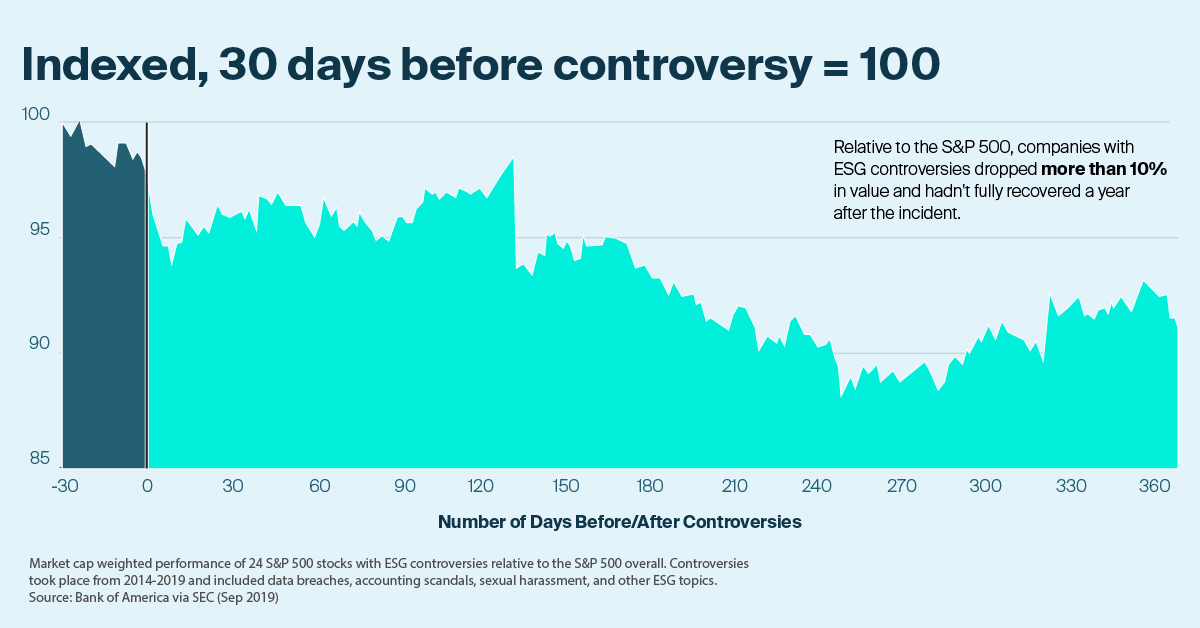ESG Data: The Four Motivations Driving Usage

ESG Data: The Four Motivations Driving Usage
Data is key to the environmental, social, and governance (ESG) revolution. Access to granular ESG data can help boost transparency for market participants. Unfortunately, 63% of U.S. and European asset managers say a lack of quantitative data inhibits their ESG implementation.
Being clear on the potential application of this data is equally important.
- Investors and banks can use ESG data for risk assessment, to spot opportunities, and to push companies for change.
- Companies can publish their own ESG data, quantify progress on their ESG goals, and use data to inform decisions.
- Policymakers can use ESG data to inform regulatory frameworks and measure policy effectiveness.
This graphic from ICE, the second in a three part series on the ESG toolkit, explores four primary motivations of ESG data users.
1. Right Thing
The objective: Having a positive social or environmental impact.
For investors, this can involve screening out companies that conflict with their values and selecting companies that align with their ESG objectives.
As another example, it can involve comparing the social impact of municipal bonds. One way investors can measure social impact is through scores that quantify the potential socioeconomic need of an area, using metrics like poverty and education levels. Here are the social impact scores for three actual municipal bonds issued in Florida.
| State | Bond Issuer | Social Impact Score (Higher = larger potential impact) |
|---|---|---|
| Florida | Issuer #1 | 76.5 |
| Florida | Issuer #2 | 66.6 |
| Florida | Issuer #3 | 43.2 |
Issuer #1’s bond is projected to have a community impact that is nearly twice as high/positive as Issuer #3’s bond.
For companies, doing the right thing can include assessing their progress on ESG goals and benchmarking themselves to peers. For example, gender and racial representation is a growing area of focus.
2. Risk
The objective: Managing ESG risks, such as climate and reputational risks.
For investors, this can involve back-testing or analysis around specific risk events before they materialize. Here are the risk profiles of two actual municipal bonds in California. The shown bonds are practically identical in many ways, except their wildlife score.
| Issuer #1 | Issuer #2 | |
|---|---|---|
| Current Coupon Rate | 5.0% | 5.0% |
| Maturity Date | Aug 01, 2048 | August 01, 2048 |
| S&P Rating | AA | AA |
| Price to Date (Call Date) | Aug 01, 2027 | Aug 01, 2027 |
| Price | 122.0 | 122.0 |
| Yield | 1.0% | 1.0% |
| Wildfire Score (Higher = more risk) | 3.6 | 2.7 |
Managing ESG risk can also involve analyzing a company’s policies and governance for weaknesses. This is important as an ESG controversy can have long-lasting effects on the valuation of a company.
In one study, companies with ESG controversies dropped more than 10% in value relative to the S&P 500. They hadn’t fully recovered a year after the incident.
3. Revenue
The objective: Targeting outperformance through ESG analysis.
Selecting companies with strong ESG data can align with long-term growth trends and may help boost performance. For heavy emitting industries, research indicates that European companies with lower emissions trade at much higher valuations. The chart below shows companies’ price-to-book ratio relative to the Stoxx 600* sector median.
| Utilities | Energy | Materials | |
|---|---|---|---|
| Above Median Emission Intensity (Bad) | 1.9 | 1.1 | 2.0 |
| Below Median Emissions Intensity (Good) | 2.7 | 1.9 | 2.1 |
*The Stoxx 600 Index represents large, mid and small capitalization companies across 17 countries of the European region: Austria, Belgium, Denmark, Finland, France, Germany, Ireland, Italy, Luxembourg, the Netherlands, Norway, Poland, Portugal, Spain, Sweden, Switzerland and the United Kingdom.
Energy companies with low emissions trade at a valuation nearly two times higher than energy companies with high emissions.
4. Regulation
The objective: Understanding and complying with relevant ESG regulation.
The International Sustainability Standards Board has announced a global reporting proposal aligned with the Task Force on Climate-related Financial Disclosures (TCFD). In addition, a growing number of jurisdictions will require organizational reporting that aligns with the TCFD.
- Brazil
- European Union
- Hong Kong
- Japan
- New Zealand
- Singapore
- Switzerland
- UK
Not only that, a European Union regulation known as Sustainable Finance Disclosure Regulation (SFDR) came into effect in 2021. It seeks greater transparency in disclosures from firms marketing investment products. Even firms located outside the EU could be impacted if they serve EU customers. In total, the market cap of these non-EU companies exposed to SFDR amounts to $3.2 trillion.
Matching ESG Data with Motivation
There will be growing demand for transparent data as ESG investing flourishes. To remain competitive, investors, policymakers, and companies need access to ESG data that meets their unique objectives.
In Part 3 of the ESG Toolkit series sponsored by ICE, we’ll look at key sustainability index types.

-

 Sponsored3 years ago
Sponsored3 years agoMore Than Precious: Silver’s Role in the New Energy Era (Part 3 of 3)
Long known as a precious metal, silver in solar and EV technologies will redefine its role and importance to a greener economy.
-

 Sponsored7 years ago
Sponsored7 years agoThe History and Evolution of the Video Games Market
Everything from Pong to the rise of mobile gaming and AR/VR. Learn about the $100 billion video games market in this giant infographic.
-

 Sponsored8 years ago
Sponsored8 years agoThe Extraordinary Raw Materials in an iPhone 6s
Over 700 million iPhones have now been sold, but the iPhone would not exist if it were not for the raw materials that make the technology…
-

 Sponsored8 years ago
Sponsored8 years agoThe Industrial Internet, and How It’s Revolutionizing Mining
The convergence of the global industrial sector with big data and the internet of things, or the Industrial Internet, will revolutionize how mining works.





